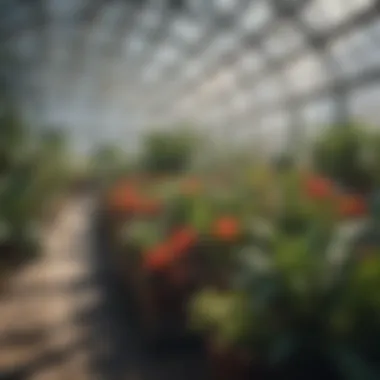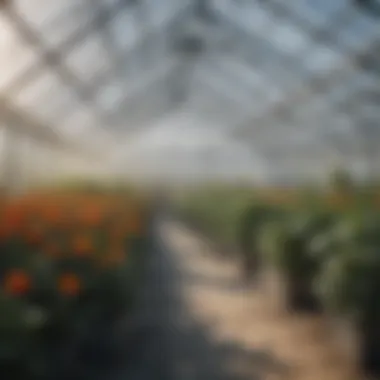The Importance of Heaters in Greenhouses Explained


Intro
Greenhouses serve as a sanctuary for various plant species, allowing gardeners to control and enhance growing conditions. Temperature regulation is a vital factor that can impact plant health directly. Without adequate heating, plants may suffer during cold months, affecting their growth and yields. This article examines the necessity of heaters in greenhouses, offering insights into the importance of temperature control, the heating options available, and the overall implications on energy efficiency and cost.
Understanding the balance between maintaining warmth and optimizing energy consumption is crucial for greenhouse owners and gardening enthusiasts alike. This narrative delves into the factors influencing the selection of heating systems, why they matter, and the broader implications of their use.
Understanding Greenhouse Functionality
Understanding how greenhouses function is integral to grasping the overall necessity of heaters within these structures. Greenhouses create controlled environments that enhance plant growth, optimizing conditions that may not be achievable outdoors. They trap solar energy, maintaining higher temperatures than the outside air, which is crucial for certain plants, especially in regions with unpredictable climates.
The Role of Temperature in Plant Growth
Temperature plays a vital role in plant growth. Plants have specific temperature ranges within which they thrive. Optimal temperatures promote photosynthesis, encouraging healthy growth and flowering. When temperatures dip below these levels, plant metabolism slows, impacting growth rates. For certain species, particularly tropical ones, maintaining higher temperatures is essential. Without adequate heating, the risks of stunted growth or even plant death increase significantly.
Moreover, temperature affects moisture levels. High humidity can be beneficial, but too cold can lead to condensation, increasing disease risk. Thus, keeping a stable temperature is not just about warmth; it also influences environmental humidity, affecting overall plant health and resilience.
Greenhouse Microclimates
Greenhouse microclimates are unique, localized climatic zones that form inside the greenhouse. These zones can differ significantly from external conditions. Factors such as sunlight exposure, plant transpiration, and structural materials contribute to these microclimates. In essence, certain areas of a greenhouse may be warmer or cooler than others.
To illustrate, areas near ventilation points may cool more rapidly. Meanwhile, spots close to heat sources, like heaters or sun-warmed windows, may warm up quicker. Understanding these variations is critical when designing heating solutions. Targeting heating efforts effectively can improve overall plant health by ensuring that all areas of the greenhouse maintain optimal growing conditions.
"The successful cultivation of plants in a greenhouse relies heavily on understanding the intricate interplay of temperature, humidity, and light within its microenvironments."
In summary, comprehending how greenhouses function, especially regarding temperature and microclimates, lays the foundation for recognizing the necessity of heating systems. Without proper heating, the controlled environment that greenhouses promise becomes compromised, making it challenging for plants to reach their full potential.
Factors Influencing Temperature in Greenhouses
Understanding the factors influencing temperature in greenhouses is crucial for effective plant cultivation. Temperature directly affects growth rates, plant health, and overall yield. Maintaining optimal conditions can maximize productivity and quality. It involves many elements, including geographical location, seasonal variations, and the materials used in the greenhouse design. By carefully considering these factors, greenhouse owners can ensure better management and healthier plants.
Geographical Location
Geographical location plays a significant role in temperature regulation within a greenhouse. Different regions have varying climate conditions, such as sunlight availability, wind patterns, and humidity levels. For instance, a greenhouse in a northern area may struggle with low temperatures during the winter months, while a greenhouse in a tropical zone may need cooling strategies due to high heat throughout the year. The amount of natural light received also drastically depends on latitude.
Key Considerations:
- Climate Type: Know if it is temperate, tropical, or arid, as this affects heating needs.
- Sunlight Exposure: Track sunlight hours to optimize heating systems.
- Local Weather Patterns: Understanding prevailing winds and storms can help in planning for insulation or ventilation strategies.
This localized understanding allows for enhanced temperature control solutions tailored to specific environmental conditions, significantly improving greenhouse efficiency.
Seasonal Variations
Seasonal changes bring about fluctuating temperature conditions, presenting challenges for greenhouse management. Spring may provide ideal conditions for plants to thrive, while winter might require precise heating strategies to maintain suitable conditions. The transition between seasons can also become critical; for instance, a sudden drop in temperature can affect sensitive plants.
Benefits of Recognizing Seasonal Variations:
- Timely Heating Adjustments: Enables timely installation of heating solutions during colder months.
- Crop Scheduling: Helps farmers plan for planting and harvesting to maximize growth cycles.
- Protection Measures: Knowledge of seasonal impacts can promote adequate preventive strategies against temperature shocks.
Understanding and proactively managing these seasonal shifts leads to increased crop resilience and ensures consistent temperature control year-round.
Material and Design of the Greenhouse
The material and design of a greenhouse significantly influence its internal temperature. The type of glazing used, whether it is glass, polycarbonate, or polyethylene, affects light transmission and insulation. Each material has its pros and cons in terms of heat retention and heat loss.
Main Considerations for Greenhouse Design:
- Thermal Mass: Incorporating materials that absorb heat can help stabilize temperature fluctuations.
- Ventilation Systems: Efficient ventilation design allows for air circulation, preventing overheating during sunny days.
- Insulation Techniques: Improved insulation methods can reduce heating costs while keeping temperatures stable even in extreme conditions.


Thus, an intelligently designed greenhouse can enhance thermal efficiency, supporting the growth of the plants within by maintaining optimal temperatures.
When establishing a greenhouse, carefully assess the geographical location, seasonal changes, and materials used to ensure an optimal environment for plant growth.
By focusing on these factors, greenhouse owners can create a favorable microenvironment that maximizes plant health and productivity.
Do Greenhouses Need Heating?
In any discussion surrounding greenhouse management, the question of whether greenhouses need heating is fundamental. This inquiry is not merely about comfort but about sustaining plant vitality. As climate conditions fluctuate, the implications of inadequate heat become starkly clear. Essentially, the heating in greenhouses becomes more than a luxury; it transforms into a necessity for many horticulturists.
Plants differ significantly in their thermal requirements, which necessitates a tailored approach to heating. Insufficient warmth can lead to suboptimal growth and development for various species, impacting their overall health. Each plant has unique temperature requirements, and understanding these needs is critical.
Analyzing Plant Species Requirements
Every plant species has its own tolerable temperature range. For instance, tropical plants often require consistent warmth, while others, such as certain vegetables, may tolerate cooler conditions. Heaters help maintain these optimal temperature ranges, especially during colder months. If a greenhouse is not heated adequately, sensitive plants may exhibit stunted growth, yellowing leaves, or even die. This specificity of requirements reinforces the need for effective heating methods.
Additionally, seedlings and young plants are particularly vulnerable to cold. A boost in temperature can be crucial in their developmental stages.
Impact on Crop Yield and Quality
The relationship between temperature and crop yield is well established. Research shows that stable, appropriate temperatures can increase yields significantly. Unheated greenhouses risk lower productivity. If crops do not receive the needed heat, the yield can diminish as plants fail to develop properly. Furthermore, not just the quantity but also the quality of crops may vary with temperature management.
Higher temperatures can lead to better flavors in fruits and vegetables. On the contrary, inadequate heating may lead to poor quality. This distinction highlights the importance of heaters in nurturing not just more plants, but better ones.
Consequences of Low Temperatures
Low temperatures pose a series of risks to greenhouse environments. Apart from affecting plant growth, low temperatures can also promote diseases. Cold, damp conditions are a breeding ground for pathogens, potentially devastating entire crops. Furthermore, frost exposure can damage plant tissues, leading to irreversible harm.
In summary, heaters in greenhouses are integral not only for maintaining a stable environment but also for ensuring the health and productivity of plants. As the demands for high-quality agricultural produce continue to grow, investing in heating solutions becomes an essential consideration for every greenhouse owner.
"Greenhouses without adequate heating systems jeopardize both plant health and crop yield, revealing the critical role of temperature management in gardening."
Heating Options for Greenhouses
Understanding the various heating options available for greenhouses is crucial for maximizing plant growth and optimizing energy consumption. Each type of heater carries specific features, benefits, and drawbacks. Therefore, selecting the right heating system can directly impact not only the efficiency of your greenhouse but also overall crop yield and quality. Here, we explore four primary types of heating options: Electrical Heaters, Gas Heaters, Solar Heating Systems, and Heat Mat Systems.
Electrical Heaters
Electrical heaters are often favored for their ease of installation and maintenance. They are available in various styles, suitable for different greenhouse sizes and layouts. Electrical heaters do not produce fumes, leading to cleaner air circulation within the greenhouse. They can be controlled easily with thermostats, allowing precise temperature management, which is vital for delicate plants.
However, relying solely on electricity may result in higher operational costs, especially in regions where electricity prices soar. It’s also essential to ensure that the electrical infrastructure can handle the load to avoid outages or potential hazards.
Gas Heaters
Gas heaters are another popular option among greenhouse growers. These systems are efficient and powerful, capable of heating large spaces quickly. They use either propane or natural gas, providing a reliable heat source even in extreme weather conditions.
One significant advantage of gas heaters is their cost-effectiveness over time. While initial installation can be expensive, the long-term savings on energy bills can be substantial. However, gas heaters require proper ventilation to prevent buildup of harmful gases. Therefore, safety must be prioritized when implementing these systems.
Solar Heating Systems
Solar heating systems harness the sun’s energy to provide warmth, making them an environmentally friendly option. These systems typically consist of solar panels and thermal storage components. The ability to utilize a renewable resource can significantly reduce heating costs over time.
While the initial investment can be high due to the cost of solar panels, many find that the long-term savings and reduced carbon footprint are worth it. However, solar heating may not provide sufficient warmth during cloudy days or winter months. Therefore, it might be beneficial to combine this system with auxiliary heating solutions.
Heat Mat Systems
Heat mat systems are particularly useful for seed starting and growing young plants. These mats distribute warmth evenly across the bottom of pots or trays, creating an optimal environment for root growth. They are simple to use and can be placed under seed trays for efficient warming.
While the initial cost is relatively low, heat mat systems often require careful monitoring of temperature to prevent overheating, which can harm plants. Additionally, their area of coverage is limited compared to other heating options. Thus, they are best utilized in conjunction with other heating systems.


Advantages and Disadvantages of Greenhouse Heaters
Understanding the advantages and disadvantages of greenhouse heaters is essential for anyone considering heating systems for their greenhouse. This topic encapsulates a range of factors, from financial implications to energy considerations. Being aware of these elements can guide greenhouse owners in making informed decisions. Balancing benefits with drawbacks is key to optimal greenhouse management.
Cost Analysis
When analyzing the cost of greenhouse heaters, several components must be considered. Initial investment can be substantial, especially for systems like gas or electrical heaters. Costs include not just the purchase of the heater but also installation and potential modifications needed in the greenhouse itself. Therefore, it is vital to calculate the total expenditure accurately.
Operating expenses are another significant aspect. Different heating systems have varying energy consumption rates. For example, electrical heaters may show higher ongoing costs due to electricity prices that fluctuate by region. In contrast, gas heaters can sometimes offer more stable long-term costs. Assessing the overall cost-effectiveness of a heating solution is crucial, especially in scenarios where budget constraints exist.
Energy Efficiency
Energy efficiency is a top concern for greenhouse heaters. Efficient heating systems lead to lower operational costs and less environmental impact. Many modern heaters come with efficiency ratings that help owners choose the right one. Systems such as solar heating can substantially reduce reliance on traditional energy sources.
Proper insulation and heat distribution strategies also play an important role in enhancing the efficiency of these heaters. A well-insulated greenhouse will maintain heat longer, reducing the workload on the heater and conserving energy. By implementing energy-efficient technologies and strategies, greenhouse owners can optimize their setup while still ensuring plants thrive.
Environmental Considerations
The environmental impact of heating systems cannot be overlooked. Different heaters have varied carbon footprints. For instance, gas-based systems can emit greenhouse gases, while electric heaters linked to renewable energy sources can minimize environmental harm.
Sustainable practices become vital, especially for owners who are ecologically conscious. Utilizing renewable sources, such as solar panels, integrates environmentally-friendly practices with effective heating solutions. Though the initial setup for such systems may be higher, long-term benefits often outweigh the costs, promoting sustainability in greenhouse operation.
"Choosing an appropriate heating system requires balancing cost, energy efficiency, and environmental considerations. Failure to do so can result in financial strain and negatively impact climate initiatives."
By understanding these advantages and disadvantages, greenhouse owners can make informed choices that balance their needs with larger sustainability goals. The investment in heaters should reflect the individual requirements of their greenhouse environment, while also considering the bigger picture.
Optimizing Greenhouse Heating Efficiency
Optimizing heating efficiency in greenhouses is crucial for several reasons. Firstly, it ensures that plants receive the optimal temperature necessary for their growth, especially in regions with extreme weather conditions. Secondly, effective heating strategies can minimize energy expenses, which is a significant concern for many greenhouse owners. By improving heating efficiency, one can also reduce their carbon footprint, which is increasingly important in our environmentally conscious era.
Insulation Techniques
Insulation is a critical component when it comes to maintaining greenhouse temperatures. The main goal of insulation is to minimize heat loss, allowing the structure to retain warmth during colder periods. Effective insulation techniques include using double-glazed glass or polycarbonate panels. Both materials help create a barrier to prevent heat escape. Additionally, adding thermal curtains during the night can provide an extra layer of insulation.
Another effective method is the use of insulating blankets or wraps around the greenhouse. These materials are designed specifically to reduce heat loss. As an alternative, consider insulating the ground. Laying materials like straw or wood chips can help keep the base warm, promoting a consistent temperature throughout the greenhouse.
Heat Distribution Strategies
Once heating is achieved, it is crucial that heat is distributed uniformly throughout the greenhouse. Uneven distribution can lead to hotspots and cold zones, impacting plant health. A well-planned layout for heating systems is essential; floor heating can be effective in providing uniform warmth, as heat rises from the ground.
In addition, deploying fans is an efficient way to promote heat circulation. By using fans, warm air can be pushed towards cooler areas, ensuring that all sections of the greenhouse are kept at a stable temperature. Another approach is zoned heating where more heat is delivered to areas requiring extra warmth, like seedling sections or tropical plant areas.
"Implementing effective heat distribution strategies is as critical as generating the heat itself."
Alternatives to Heating Systems
In the context of greenhouses, heating systems are typically viewed as essential for maintaining optimal growing conditions. However, there are several alternatives that merit attention. These alternatives can not only reduce reliance on traditional heating methods but also contribute to sustainability and cost-effectiveness. The exploration of such options is crucial for greenhouse owners who seek to minimize energy consumption while still providing a conducive environment for plant growth.
Passive Heating Techniques
Passive heating techniques incorporate natural energy sources to maintain warmth in greenhouses. By utilizing sunlight, these methods rely on design and material choices rather than active heating systems. One common approach is optimizing orientation and placement to maximize sun exposure. South-facing greenhouses receive the most sunlight, making them ideal for passive heating.
Key aspects of passive heating techniques include:
- Solar Gain: The design that traps sunlight can significantly increase the internal temperature of a greenhouse, particularly during sunny winter days.
- Ventilation: Proper airflow helps to prevent overheating on warmer days while allowing for temperature control.
- Heat Retention: Using thermal mass materials like stone or concrete can store heat absorbed during the day, gradually releasing it at night.
These techniques not only save energy but also lower operational costs. However, passive systems require careful planning. The effectiveness largely depends on the local climate and the specific plants being cultivated.
Thermal Mass Utilization


Thermal mass utilizes materials that have high heat capacities to store and release heat as temperature fluctuations occur. This method provides an effective way to stabilize temperatures in greenhouses. Various materials can be employed for thermal mass, such as water tanks, bricks, and stone walls.
Considerations when implementing thermal mass include:
- Material Selection: Specific materials are better suited for heat retention. Water, for instance, has excellent thermal properties, making it a popular choice.
- Placement: Locating thermal mass strategically within the greenhouse enhances its effectiveness, ensuring heat is distributed evenly.
- Monitoring Feedback: Observing temperature changes can optimize the system and determine how much heat is absorbed or released throughout the day.
Utilizing thermal mass can significantly temper the extremes of day and night temperatures, providing more stable conditions conducive to plant health. While this technique does not replace heating systems, it offers a practical alternative that can reduce dependency on them.
"Exploring alternatives to heating not only elevates sustainability goals but can also improve the overall management of greenhouse environments."
In summary, utilizing passive heating techniques and thermal mass can be viable alternatives to traditional heating systems. These methods promote energy efficiency and may be particularly beneficial for greenhouse owners seeking sustainable strategies.
Case Studies
Case studies offer a significant insight into the real-world applications of heating systems in greenhouses. They serve as practical examples that highlight the effectiveness and necessity of heaters in various scenarios. By analyzing different implementations, greenhouse owners can grasp the specific conditions under which heating becomes crucial. This section provides valuable benefits and considerations about case studies that can guide decision-making.
Successful Heating Implementation
In many instances, greenhouses that successfully integrated heating systems yielded greater plant growth and higher-quality crops. For example, a greenhouse in Michigan employed a gas heater alongside heat mats to maintain consistent temperatures during the harsh winter months. The result was an increase in the overall productivity of vegetables such as tomatoes and peppers.
Key factors behind this success include:
- Targeted Temperature Maintenance: The heater maintained optimal temperatures even during extreme cold.
- Crop Diversity: With proper heating, the owner expanded the variety of plants cultivated.
- Extended Growing Season: A reliable heating system allowed for earlier planting than typically possible.
An important takeaway from this example is the potential to enhance crop yield significantly. By ensuring the right conditions, greenhouse owners can make informed choices about the types of heating systems that best meet their specific needs.
Consequences of Neglecting Heating
On the opposite end, the lack of heating can lead to adverse outcomes for greenhouse operations. A notable example can be seen in a greenhouse located in Southern Canada, where the owner decided against installing any heating systems to save costs. The harsh winter brought freezing temperatures, which adversely affected the plants. Many seedlings did not survive, leading to a substantial financial loss.
Considerable consequences of neglecting heating include:
- Crop Loss: Vulnerable plants may not withstand cold conditions.
- Delayed Growth: Lower temperatures can slow down growth rates significantly.
- Reduced Profitability: Loss of produce directly translates into lost revenue.
As highlighted in this scenario, overlooking heating systems can undermine the very purpose of a greenhouse. The investment in heating is often minor compared to the potential losses incurred from neglecting temperature control.
"Effective heating not only protects crops but can also increase the diversity and longevity of greenhouse operations."
Understanding these case studies allows greenhouse owners to make informed decisions about the necessity of implementing heating systems. It frames the analysis of heating strategies in the context of real-world results, emphasizing the critical nature of these systems for successful greenhouse management.
Finale: Evaluating the Need for Heaters in Greenhouses
The importance of heating systems in greenhouses cannot be overstated. As discussed throughout this article, temperature control plays a vital role in establishing an optimal environment for plant growth. Without adequate heating, greenhouses may fail to maintain the necessary warmth, especially during colder months. This can result in stunted growth, reduced crop yield, and compromised plant health.
Specific Elements to Consider:
- Temperature Control: Greenhouses are designed to harness sunlight, but their ability to retain heat varies. Heaters can mitigate heat loss and maintain stable temperatures.
- Impact on Plant Species: Different plant species have unique temperature requirements. Heaters ensure these needs are met, promoting healthy growth.
- Crop Quality and Yield: Managing temperatures effectively leads to better crop quality. Higher yields achievable through precise temperature control ultimately benefit greenhouse owners economically.
Final Thoughts
In light of the information presented, it becomes clear that the role of heaters transcends basic temperature maintenance. They contribute to mitigating risks associated with weather unpredictability. Integrating suitable heating systems culminates in more predictable outcomes concerning growth rates and the timing of harvests. As the global climate continues to change, the adaptability of greenhouse systems becomes even more paramount.
Key Takeaways:
- Heaters are essential for consistent growing conditions.
- Different heating options can cater to specific greenhouse designs and plant needs.
- Long-term success in greenhouse gardening relies on being proactive about heating solutions.
Future Considerations for Greenhouse Owners
As greenhouse technology evolves, greenhouse owners should keep abreast of new developments. Future strategies may include more sustainable heating options, such as combined heat and power systems or geothermal heating. Adopting practices that minimize energy expenditure will enhance both profitability and environmental responsibility.
Factors to Monitor:
- Energy Efficiency: Enhanced methods for insulation and heat retention in greenhouses will continue to emerge.
- Climate Resilience: Selecting plant varieties that are less dependent on strict temperature controls can be advantageous.
- Cost Management: Continuous assessment of heating costs in relation to crop yield will be essential for maintaining financial viability.
In summary, understanding the long-term implications of heating systems in greenhouses will empower owners to create sustainable and productive environments. As horticultural practices advance, embracing innovation will be key to thriving in the ever-evolving landscape of greenhouse gardening.







